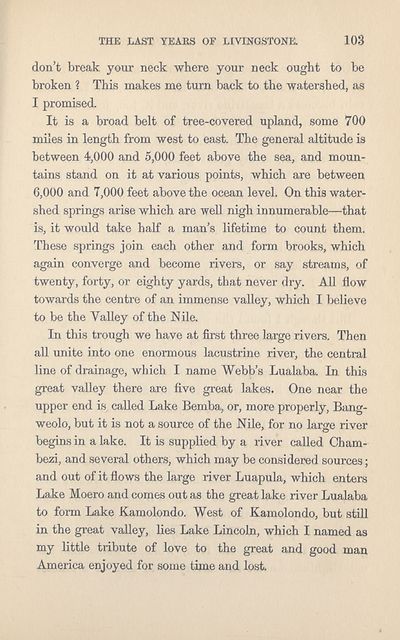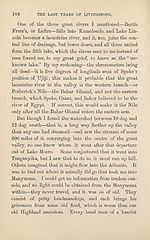Download files
Complete book:
Individual page:
Thumbnail gallery: Grid view | List view

THE LAST YEARS OF LIVINGSTONE.
don’t break your neck where your neck ought to be
broken ? This makes me turn back to the watershed, as
I promised.
It is a broad belt of tree-covered upland, some 700
miles in length from west to east. The general altitude is
between 4,000 and 5,000 feet above the sea, and moun¬
tains stand on it at various points, which are between
6,000 and 7,000 feet above the ocean level. On this water¬
shed springs arise which are well nigh innumerable—that
is, it would take half a man’s lifetime to count them.
These springs join each other and form brooks, which
again converge and become rivers, or say streams, of
twenty, forty, or eighty yards, that never dry. All flow
towards the centre of an immense valley, which I believe
to be the Valley of the Nile.
In this trough we have at first three large rivers. Then
all unite into one enormous lacustrine river, the central
line of drainage, which I name Webb’s Lualaba. In this
great valley there are five great lakes. One near the
upper end is called Lake Bemba, or, more properly, Bang-
weolo, but it is not a source of the Nile, for no large river
begins in a lake. It is supplied by a river called Cham-
bezi, and several others, which may be considered sources;
and out of it flows the large river Luapula, which enters
Lake Moero and comes out as the great lake river Lualaba
to form Lake Kamolondo. West of Kamolondo, but still
in the great valley, lies Lake Lincoln, which I named as
my little tribute of love to the great and good man
America enjoyed for some time and lost.
don’t break your neck where your neck ought to be
broken ? This makes me turn back to the watershed, as
I promised.
It is a broad belt of tree-covered upland, some 700
miles in length from west to east. The general altitude is
between 4,000 and 5,000 feet above the sea, and moun¬
tains stand on it at various points, which are between
6,000 and 7,000 feet above the ocean level. On this water¬
shed springs arise which are well nigh innumerable—that
is, it would take half a man’s lifetime to count them.
These springs join each other and form brooks, which
again converge and become rivers, or say streams, of
twenty, forty, or eighty yards, that never dry. All flow
towards the centre of an immense valley, which I believe
to be the Valley of the Nile.
In this trough we have at first three large rivers. Then
all unite into one enormous lacustrine river, the central
line of drainage, which I name Webb’s Lualaba. In this
great valley there are five great lakes. One near the
upper end is called Lake Bemba, or, more properly, Bang-
weolo, but it is not a source of the Nile, for no large river
begins in a lake. It is supplied by a river called Cham-
bezi, and several others, which may be considered sources;
and out of it flows the large river Luapula, which enters
Lake Moero and comes out as the great lake river Lualaba
to form Lake Kamolondo. West of Kamolondo, but still
in the great valley, lies Lake Lincoln, which I named as
my little tribute of love to the great and good man
America enjoyed for some time and lost.
Set display mode to:
![]() Universal Viewer |
Universal Viewer | ![]() Mirador |
Large image | Transcription
Mirador |
Large image | Transcription
| Antiquarian books of Scotland > Scotland/Scots > Last years of Livingstone > (111) |
|---|
| Permanent URL | https://digital.nls.uk/136058494 |
|---|
| Description | Thousands of printed books from the Antiquarian Books of Scotland collection which dates from 1641 to the 1980s. The collection consists of 14,800 books which were published in Scotland or have a Scottish connection, e.g. through the author, printer or owner. Subjects covered include sport, education, diseases, adventure, occupations, Jacobites, politics and religion. Among the 29 languages represented are English, Gaelic, Italian, French, Russian and Swedish. |
|---|

